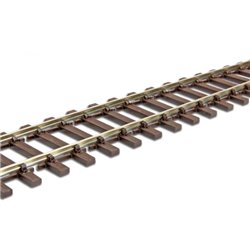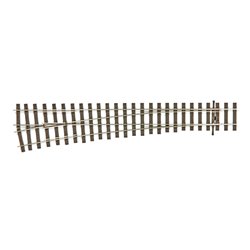There are a number of different options for attaching figures such as a horse and rider to a layout. Perhaps the...
No products
Product successfully added to your shopping cart
There are 0 items in your cart. There is 1 item in your cart.
Search Tips
What is bullhead rail?
Bullhead rail is a type of railway rail that was prominently used in the United Kingdom and other parts of the world from the early 19th century until the mid-20th century. Characterised by its distinctive cross-sectional shape, bullhead rail features a symmetrical profile with two rounded heads and a narrower web in the middle. This design resembles the profile of a bull’s head, which is how it earned its name. Initially, bullhead rails were designed with the idea that the top and bottom could be interchangeable; when the top head became worn down from use, the rail could theoretically be inverted and reused. However, in practice, this was seldom done due to the wear and deformation that occurred in service, making it difficult to achieve a perfect fit on the reused surface.
Bullhead rails were traditionally installed in pairs, fixed to cast iron or steel chairs using wooden keys or wedges. These chairs were mounted on wooden sleepers (also known as ties), which provided stability and support to the track. The chair's role was to keep the rail upright and maintain the proper gauge, or distance, between the two rails. This system, while effective at the time, required a considerable amount of maintenance. The wooden keys often needed to be adjusted or replaced due to weather-related expansion and contraction, which could lead to looseness and potential track misalignment.
The historical significance of bullhead rail cannot be overstated. It was the predominant rail profile during the rapid expansion of rail networks across Britain and its colonies, becoming synonymous with the great age of steam locomotion. Its introduction and widespread use were part of the industrial advancements of the 19th century, providing the necessary infrastructure for transporting goods and people across vast distances at unprecedented speeds. This facilitated economic growth and regional development, making railways a backbone of industrial societies.
Despite its advantages, bullhead rail had several drawbacks, particularly in terms of maintenance. The design, while innovative for its time, was labour-intensive to maintain. The need to frequently inspect and replace wooden keys and occasionally reposition chairs added to operational costs. Additionally, the dual-headed design meant that only half of the material was effectively used for its primary purpose—the top running surface. As technology and engineering practices evolved, these inefficiencies led to the gradual phasing out of bullhead rails in favour of more modern designs.
By the mid-20th century, flat-bottom rail, also known as Vignoles rail, started to replace bullhead rail in many parts of the world, including the UK. Flat-bottom rails are more economical to produce and install, as they do not require the complex chair systems needed for bullhead rails. They also offer greater stability and strength, as the broader base allows for better distribution of weight and forces exerted by passing trains. The flat-bottom design has become the standard in contemporary rail infrastructure due to its durability and lower maintenance requirements.
Despite the shift to flat-bottom rails, bullhead rail has not disappeared entirely. In the UK, it is still found on some heritage railways and light rail systems, where historical authenticity is valued. The London Underground, for instance, still uses bullhead rail on some of its lines, and certain rural and less-trafficked routes maintain these rails due to the cost-effectiveness of reusing existing track systems. Enthusiasts and railway preservation societies also maintain bullhead rail tracks as part of their efforts to preserve the rich history of rail transport.
In conclusion, bullhead rail represents a significant chapter in the history of railway engineering. Its unique design and historical importance highlight the technological advances of its time and its role in shaping modern transport infrastructure. While no longer the dominant rail profile, the legacy of bullhead rail endures in the UK and beyond, serving as a testament to the evolution of railway technology and the ongoing importance of rail transport in society.
Click here to receive the tips weekly in your mailbox. You can unsubscribe at any time.










